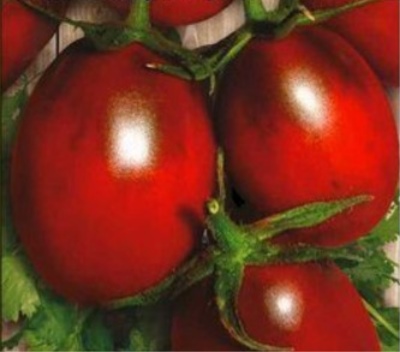
- Category: grade
- Growth type: indeterminate
- Appointment: fresh consumption, for whole fruit preservation
- Ripening period: mid-season
- Ripening time, days: 110-120
- Marketability: high
- Bush size: tall
- Bush height, cm: up to 200
- Bush characteristic: compact
- Ripe fruit color: chocolate
Tomato Prunes are considered by many to be one of the most original vegetables in shape and color. However, it stands out among others not only for its unusual appearance, but also for its wonderful taste. The fruits of the variety contain a balanced amount of nutrients, such as pigments, vitamins, sugars, trace elements. Yet its main advantage is its very high yield.
Description of the variety
Despite its tallness, the indeterminate prune bush is quite compact. Although it can grow up to two meters in height. The leaves on it are painted in a light green tone. Brushes of a simple structure, each of which forms from 6 to 8 berries.
The main qualities of the fruit
The fruits of the tomato variety in question are plum-shaped. The weight of one tomato is average, up to 120 grams. Biological ripeness is marked by darkening of the tomato skin. At the same time, its color varies, it can be chocolate, maroon, dark cherry, purple.
The brightest and most intense color comes from fruits that grow under the sun. If there was not enough lighting and heat, then the color will not be so dark. In any case, the skin of a tomato Prune is beautiful, shiny, rather dense. This allows the fruit to demonstrate good transportability and a long shelf life of up to two months.
Taste characteristics
Prune tomatoes are very tasty, juicy, sweetish. For dessert purposes, they are eaten fresh, and also used in whole-fruit canning, since the skin is not prone to cracking. Application options:
- preparing summer salads;
- tomato paste;
- tomato juice;
- sauces, gravies;
- ketchup;
- garnish for meat dishes.
Due to their unusual color and interesting shape, prune tomatoes are often used as a decoration, decoration of a festive dish or salad.
Ripening and fruiting
Prunes are a tomato crop belonging to the mid-season group, as it ripens 110-120 days after the shoots have appeared.
Yield
The high-yielding variety allows you to collect up to 5 kilograms of healthy and tasty tomatoes from the bush.
The timing of planting seedlings and planting in the ground
Sowing seeds of the Prune variety for seedlings is recommended to start from the 2nd decade of March.

Growing tomato seedlings is an extremely important process, because it largely depends on whether the gardener will be able to harvest at all. All aspects must be taken into account, from seedbed preparation to planting in the ground.
Landing scheme
When planting in the ground, a number of conditions must be observed. No more than three prune tomato bushes are planted on one "square". As for the landing scheme itself, different sources give different options: 30x50 cm or 60x70 cm.

Growing and care
Tomato variety Prunes are unpretentious in the cultivation process. Moreover, it is versatile, it can be cultivated both in the greenhouse and in the open field.
To grow a good harvest of prune tomatoes, you need to follow the usual care measures:
- in the hole when landing, you can put 1 tbsp. l. superphosphate mixed with potassium sulfate;
- watering is carried out only when the soil is completely dry;
- with greenhouse cultivation, a bush of 1-2 stems is formed, while no more than 4-5 brushes should remain on the stem;
- at the stage of fruit formation, root feeding with magnesium sulfate is mandatory;
- timely removal of old leaves;
- loosening the soil, weeding;
- the need to tie bushes to a support or trellis.




A plant needs different micronutrients at each stage of growth. All fertilizers can be divided into two groups: mineral and organic. Folk remedies are often used: iodine, yeast, bird droppings, eggshells.
It is important to observe the rate and period of feeding. This also applies to folk remedies and organic fertilizers.
Disease and pest resistance
The culture has good resistance to tomato diseases such as late blight, tobacco mosaic.


Resistant to adverse weather conditions
Prune tomatoes are stress-resistant, withstand the most extreme weather conditions. The culture has good resistance to low temperatures, as well as temperature extremes. This fact makes it possible to plant varietal tomatoes in areas that are characterized by a rather cool summer season.

























































































